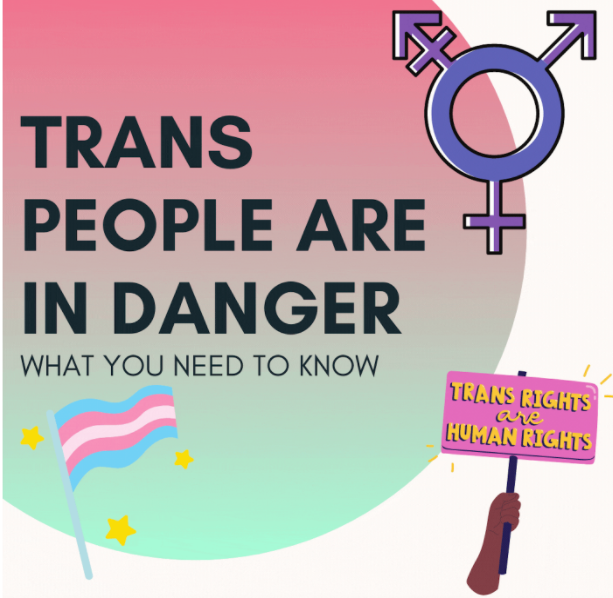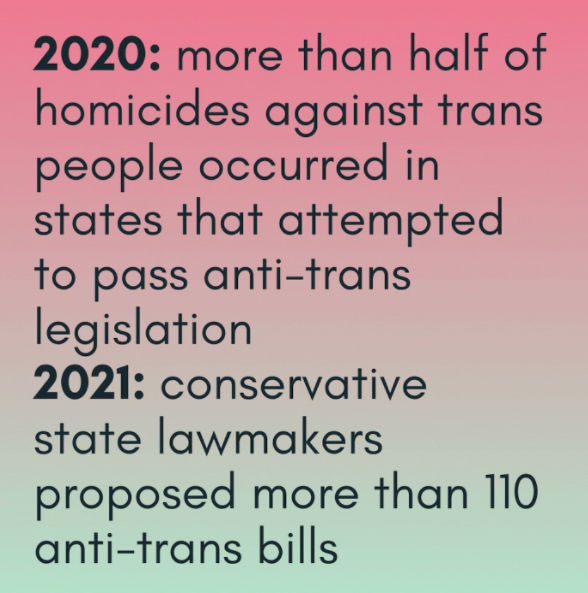SOCIAL MEDIA POST (1 Instagram with 3 slides in a carousel)
SOCIAL MEDIA POST RATIONALE: A rationale for your composition (1-2 pages) that orients your reader to the purpose of your work and its significance to your audience
For my first composition, I constructed an Instagram post with 3 slides to be posted in a carousel. The purpose of this social media post is to educate people on the current situations going on with the fight for Transgender rights and acceptance, and also to provide ways in which intended viewers can help. Since this is a social media post, there is a lot more freedom in expression than there would be in many other genres. This allowed me to use a bright background on all the slides. Considering the swipe and scroll nature of social media (where viewers scroll through posts very quickly unless their attention is immediately caught), I used a bright pink and blue background alongside many images and a video clip to catch the viewer’s attention in the fastest way possible. Using a pink and blue background also immediately gives viewers an idea of what this post may discuss (pink, blue, and white are the colors on the Transgender Pride flag). The images and video I selected all revolve around the theme of Transgender rights: the Transgender Pride flag, the Transgender symbol, cartoon people representing Trans pride, and a march for Transgender rights. Including these images both catches the viewer’s attention and also instills the post’s message of being educated and supporting Transgender rights into the viewer’s mind.
The audience of this post would primarily be my followers on Instagram, which consists majorly of Gen Z teenagers and young adult millenials living in the Northeast (a largely liberal area). Since these anti-trans bills are being passed in conservative states, my list of “WHAT TO DO”s includes more indirect approaches to helping because my audience wouldn’t live in areas where these issues are occurring to major extents. These indirect approaches include calling out family members, listening to Transgender friends, and staying educated. Although vital, these actions would improve lives on personal levels and not necessarily regional/governmental levels. On the second slide of the post, I include two quick facts that give a broad overscope of the situation at hand; I avoided giving too many facts because of the fast-paced nature of Instagram and other social media platforms that would make viewer’s lose interest in reading. I used language that I feel teenagers with some high school education would understand (“anti-trans”, “lawmakers”, etc.). I didn’t prioritize capitalization or punctuation because proper grammar is not necessary on social media as long as you concisely get your point across. This is a similar case to the next slide, where I include short bullet points listing ways to help, each followed by a single emoji that symbolizes the action described. I bolded and capitalized the main word(s) in each bullet to place emphasis on it and grasp the reader’s attention. I avoided using full sentences to ensure that audience members do not lose focus while viewing the post. The use of emojis is tailored to a younger audience because Gen Z and millenials are the primary users of emojis and are the most likely to understand their meanings. These emojis are also eye-catching and further hold onto the audience’s attention.
BLOG POST: Calling All Allies! Save Trans Youths
BLOG POST RATIONALE: A rationale for your composition (1-2 pages) that orients your reader to the purpose of your work and its significance to your audience.
The purpose of this blog article is very similar to the purpose of the social media post: to educate readers about ongoing attacks on transgender rights and provide actions they can take. However, the execution of the two pieces are very different. The blog genre allows for more standardly-formatted writing, but is not necessarily written in a very formal style. The audience I have in mind for this blog would be young adult millennials who actively stay updated on current events. I made many specific stylistic choices to tailor to this audience. Firstly, many words used were fit for a reader who already has a background in current events. Words and phrases such as “jurisdictions”, “gender-affirming treatments”, and “legislation” may not be well-fit toward younger audiences who do not know much about current events. I also kept the tone of the post candid yet casual by providing concise information and also inserting personal remarks in parentheses at some points throughout the article, such as “(none of us do)”. Inserting personal remarks such as these lightened the seriousness of the article, and differentiated it from a news article style by making it more personal and less formal. This concise, candid manner of writing is tailored toward young adults because they are far more likely to be subscribed to social media. This matches the swipe and scroll system of social media because readers can grasp information quickly before they lose focus. I also added subheadings in my blog to be eye-catching and also provide an overview of the article for skimmers in an attempt to hold audience attention. Additionally, I specifically targeted adults in this article because in the “What Can You Do?” section, I placed heavy emphasis on the suggestion to vote, stating “Vote! Vote! Vote!”. This suggests that the reader of the article is assumed to be an American citizen over age 18. The promotion of sharing this article to social media platforms at the top of the post applies to younger adults because they are far more likely to subscribe to social media than older individuals. The audience for this blog post shapes almost every aspect of the article, from format to language to graphics. Following a strategic approach suited for your intended audience increases the chances of your argument delivering effectively.
REFLECTION: A reflection that outlines the process from audience strategy to final composition, exploring the rhetorical choices—genre, stance, and rhetorical situation—you made in creating this project
The process of moving from the research essay to the composition project was a big adjustment that I thoroughly enjoyed. The two essays almost completely oppose each other in their structures, yet somehow compliment each other. The research essay required us to analyze sources of different genres in order to determine what rhetorical strategies were used for that specific genre. Conversely, for this composition project, we had to use the strategies we learned from the research essay and outside sources to construct our own pieces. I chose a social media post and a blog as my genres because I find that they compare very interestingly. A blog post and a social media post both do not require extreme formalities; however, a blog post definitely has a more set structure that must be followed. A social media post is very open to interpretation and can be taken as seriously as desired. I had a lot of fun constructing my pieces because of this lack of formality and the freedom to express my information however I wanted.
A barrier I found in constructing my social media post was that I wanted to use more slang in my post that a Gen Z/millennial audience would understand. However, it was difficult to present such important information and use slang words, because I didn’t want the information to be misrepresented. To counteract this, I placed more emphasis on emojis and informal grammar rather than actual diction. This provided some leeway in not using as informal language as some other social media posts. In the blog post, I had a similar issue, because a blog is supposed to be written more formally than a social media post, but less formally than a newspaper article. I found it difficult trying to provide almost the same information that a newspaper would but in a more casual manner. To counter this, I added my own commentary in parentheses at points in the post to add a humorous element to my writing. I also made a bullet point list that you wouldn’t find in most newspaper articles. This rhetorical practice of mixing a humorous tone with my candid tone made my pieces more affordable for my audience.
Hence, this composition project was very different from any other research or writing we’ve done in the past. There were a lot of different strategies and elements that had to go into it. However, all of our past assignments helped me realize how to best tailor my writing and style to each piece’s specific audience.






